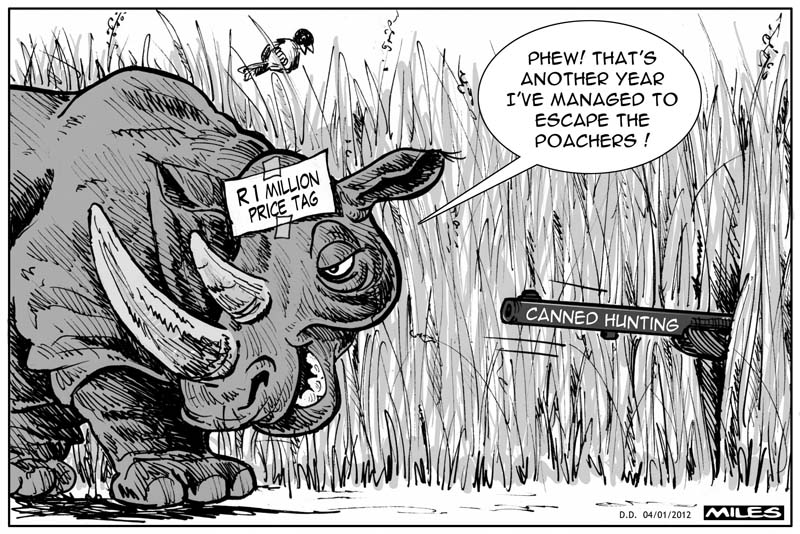
There are two related but very different stories here: the first is the growing number of scandals in the South African government; and the second is the issue of culling and hunting big game like elephants.
I’ve been trying to formulate an opinion on the first for some time, and I can’t. Jacob Zuma is the third president since the end of the apartheid era and one of the last of the old boys who were instrumental in the apartheid struggle with Nelson Mandela.
He’s also the most clumsy, the least intellectual and quite rash. His charisma is more chutzpah than boldness. But payback for being a revolutionary is winding down, and people seem more tolerant of his antics than I would expect presuming he’s on his way out.
And South African society in my opinion is doing remarkably well for having made such a gigantic transition. But scandals are one thing, and the new, growing attempt by the government to centralize power are quite another.
Zuma’s revenge for being made such fun of by the local press seems to be, among other similar acts, shutting it down in patent violation of the constitution. And the courts seem reluctant if reticent to battle him head on.
So in this climate of buffoonery morphing into odious politics, many lesser officials feel a bravado more typical of banana republic magnates than of major democracies.
So very lesser officials – nevertheless very publicly associated with Zuma and his ANC party – who oversee one of KwaZulu Natal’s big game sanctuaries, recently invited outside sportsmen to bid for the right to kill a white rhino in one of South Africa’s most famous reserves, Mkhuze.
Technically the rhino auctioned away to the highest traveling bidder was not within the exact confines of Mkhuze, but in the adjacent Makhasa private community reserve, and this provided the loophole for the overseers of this reserve to be so bone-headedly bold.
Readers may understand this better by a similar association in a more popular area, Kruger National Park, where the adjacent Sabi Sands private community reserve actually draws more American tourists.
Makhasa, like Sabi Sands, is governed to a large extent by the wildlife laws of the adjacent federal authority, between which there is no fencing. It is a single ecosystem. Kruger and Sabi Sands are in the interior far east of the country. Mkhuze and Makhasa are on the coast northeast of Durban.
Southern African wildlife management, particularly within South Africa proper, is likely the best in the world and is packed with professionals who are the stars in their fields. For a very long time they’ve believed in culling derived from intricate notions of “carrying capacity” that they believe they understand better than anyone.
Indeed, they may. The health and sustainability of southern African reserves is far greater, for example, than in East Africa. There are many more species albeit much less drama provided by the large numbers of animals seen in East Africa.
It is precisely the large numbers of animals that South African scientists see in East Africa that they insist will be East Africa’s ultimate downfall, the “tipping threshold” reached when too many unmanaged animals compete for dwindling resources. The crash that can result is often catastrophic and irreversible.
So southern African officials cull. For as long as the reserves have existed and been well managed (Kruger since 1926) culling has regularly occurred, and when the culling is of a springbok it makes much less noise than when it’s an elephant or rhino.
More scientifically, it is rare that a single elephant is culled. It is more likely (wince now) that an entire family is culled babies and all, since elephants are so social that to separate them from their family unit is generally untenable. But single rhinos are regularly culled.
Never, until now, has this excision been opened by auction to sportsmen tourists.
The winner of the auction, referred to anonymously as a “businessman” paid just over $110,000 for the right to shoot the white rhino, which by the way is an extremely docile beast, quite unlike its cousin, the black rhino. Conservation advocates screamed bloody murder, of course.
There are to be sure far too many white rhinos in southern Africa. They breed like cows and basically live like cows. You can virtually pet them. But they’re bigger than black rhinos and magnificent looking beasts. Killing them doesn’t take much skill.
There are so many of them, you can buy a white rhino for less than $10,000 although the transport and maintenance lifts that considerably. Many South African ranchers buy and breed white rhinos so they can then be hunted, and the going rate for legal hunting of such white rhinos is around $50,000, less than half what this anonymous businessman paid.
Add to this the fact that there is an epidemic of rhino poaching occurring right now in South Africa, and it’s been going on for more than a year. That bastion of extraordinary wildlife management, Kruger, has the unmitigated embarrassment of having had 11 rhinos poached this year.
So put all this together and you have to ask yourself who the hell would pay twice the going hunting rate to shoot a rhino in a protected reserve?
Answer: Someone who hasn’t a clue about most everything, e.g.: how much it usually costs, how much furore it would produce, and likely is paying quite a lot more under the table.
This is the kind of folly happening in South Africa right now in many areas of its society. It’s almost like a free-for-all. We can only hope the days of the old boys can be auctioned off as swiftly as was this white rhino.